People who have been vaccinated have to wait in the area for between 15 and 30 minutes to be monitored for potential vaccine-related side-effects. (Bhekisisa Centre for Health Journalism)

Covid-19 vaccination centres across the country opened on 17 May and by Monday, 31 May, more than 500 000 people had received the first of two Pfizer doses.
A small study on 800 people showed that the jab was 100% effective in preventing Covid-19 cases caused by 501Y.V2, the beta variant. This is the form of the Sars-CoV-2 virus that causes Covid-19 which is now dominant in the country. A paper in the New England Journal of Medicine in May said the Pfizer jab had an effectiveness of 75% against infection with the beta variant in Qatar’s real-life roll-out, in which 385 853 people had received their first dose of the jab and 265 410 had been fully immunised.
Most of South Africa’s Pfizer shots will go to vaccination centres in urban areas, because the jabs need to be kept in freezers, which aren’t always available in rural areas. The Pfizer vaccine requires two doses, which means vaccinators need to ensure that people return for their second jab, something that’s often easier to do in urban areas than in rural areas.
The Johnson & Johnson (J&J) vaccine will mainly go to rural sites, because it requires only one dose and can be stored in a fridge for up to three months.
The country’s Covid-19 vaccine implementation study, Sisonke, vaccinated about 500 000 health workers with the J&J vaccine. South Africa is waiting for a batch of 1.1-million J&J jabs to be released from Aspen’s plant in Gqeberha. Aspen can only deliver the jabs once a verification process by the US’ Food and Drug Administration has been concluded.
Bhekisisa visited the Discovery Health vaccination centre in Sandton, Johannesburg, to show you how a site works and how a Pfizer vaccine is administered.
Step 1: Arriving at the site
A long line of cars on Rivonia Road is moving slowly, waiting to enter the undercover parking lot at 1 Discovery Place in Sandton. The people in the cars are on their way to get their first shot of Pfizer’s Covid-19 jab. Only healthcare workers and people aged 60 and older can enter.
 Cars wait to enter the Discovery Covid-19 vaccination centre in Sandton, Johannesburg. (Discovery Health)
Cars wait to enter the Discovery Covid-19 vaccination centre in Sandton, Johannesburg. (Discovery Health)
No vaccination site in the country, either public or private, gets to choose their customers — the government’s booking system, the electronic vaccination data system (EVDS), decides where someone goes.
Discovery’s site usually only vaccinates people with medical aid — it can be any medical scheme. The EVDS assigns people without health insurance to public sites, unless there is no space at a government centre. Discovery says about 7% of their clients, so far, were uninsured.
Once a person has parked, they are shown to a station where their temperature is taken. If their temperature is above 37°C, they are not allowed to proceed, because they may be Covid-19-positive and infect other clients. Such customers are referred for a Covid-19 test.
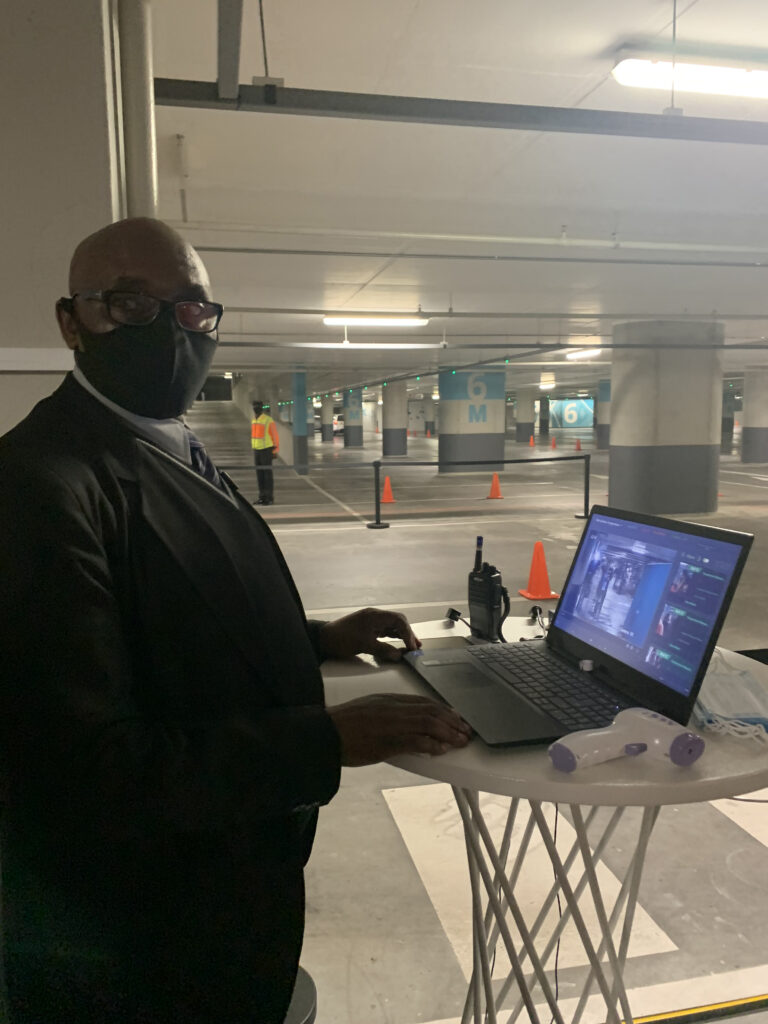 The first stop: A station where clients’ temperatures are taken and entered into a computer data system. P (Bhekisisa Centre for Health Journalism)
The first stop: A station where clients’ temperatures are taken and entered into a computer data system. P (Bhekisisa Centre for Health Journalism)
Customers whose temperature is 37°C and below are given a seat in a waiting area in the parking lot. Everyone has to wear a mask and the chairs are two metres apart.
Wheelchairs are available for those who struggle to walk.
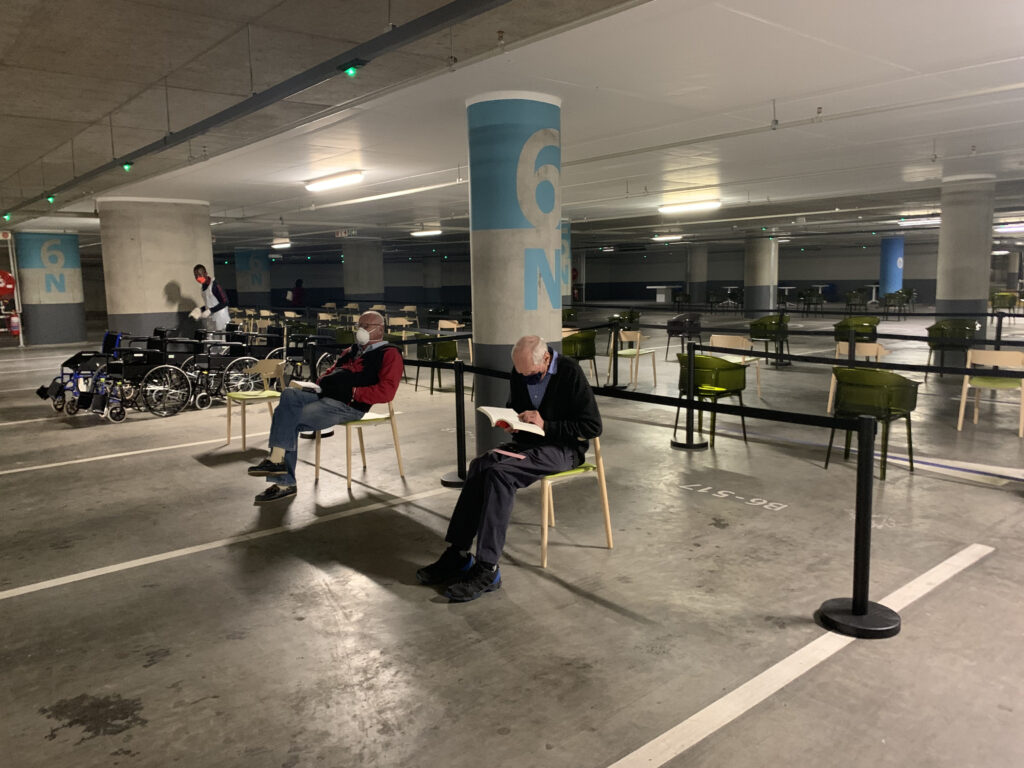 Clients wait for their turn to move on to the registration centre, which is inside the building. (Bhekisisa Centre for Health Journalism)
Clients wait for their turn to move on to the registration centre, which is inside the building. (Bhekisisa Centre for Health Journalism)
Only people with EVDS appointment vouchers are helped — but there are exceptions. Today, for instance, a wife, whose husband had a voucher, complained that she registered on the EVDS immediately after her husband, yet he got an appointment SMS and she did not. Officials allowed her to get vaccinated to save her the time and effort of returning to the centre.
“We do make exceptions based on a case-by-case basis, and specific clinical criteria,” says Ron Whelan, the head of Discovery Health’s Covid-19 task team.
“We don’t take walk-ins because we only have a certain number of vaccines available for each day, and we have to accommodate people with appointments first. In the first week of vaccinations, there was one day on which the EVDS booking system didn’t allocate patients to Discovery Place. Rather than leave the vaccination centre empty, we then took walk-ins. Even though we didn’t announce this, the news spread quickly on social media and we were quickly overwhelmed.”
The EVDS books an average of 2 300 appointments a day for the centre, says Whelan. “We’ve had very few no-shows; we’re mostly busy throughout the day.”
Step 2: Joining the queue and waiting for verification
From this waiting station, small groups of customers are called to the vaccination site’s registration centre on the ground floor of the Discovery building.
Here, they present their identity document, medical aid membership card (if they belong to a medical scheme) and their EVDS booking SMS along with the unique vaccination code that the system issued.
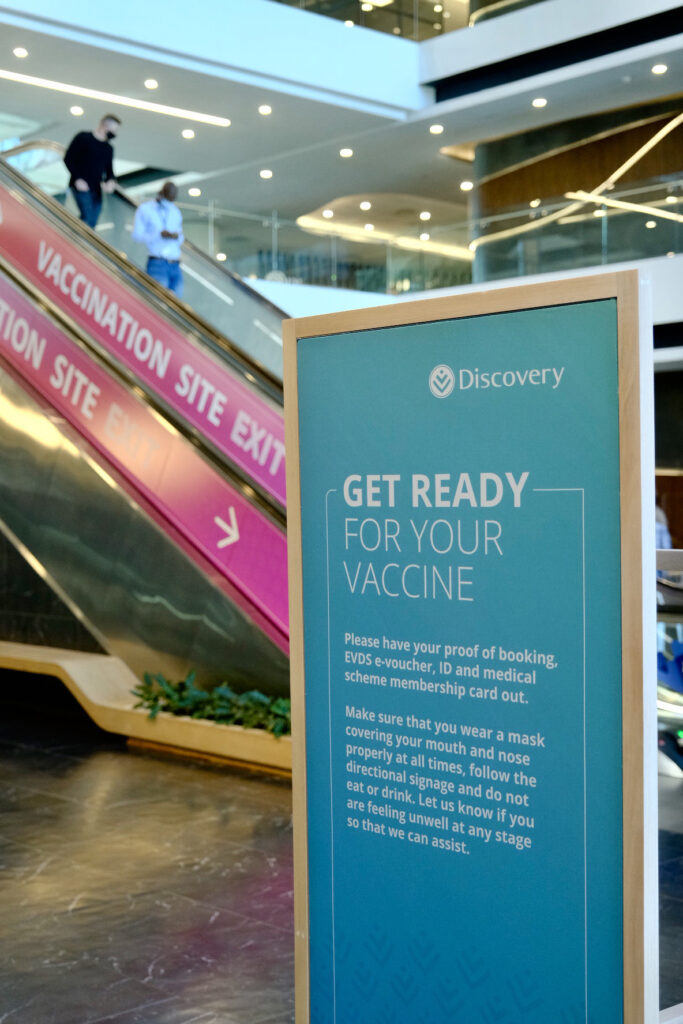 The vaccination registration centre is the first stop inside the Discovery building. (Discovery Health)
The vaccination registration centre is the first stop inside the Discovery building. (Discovery Health)
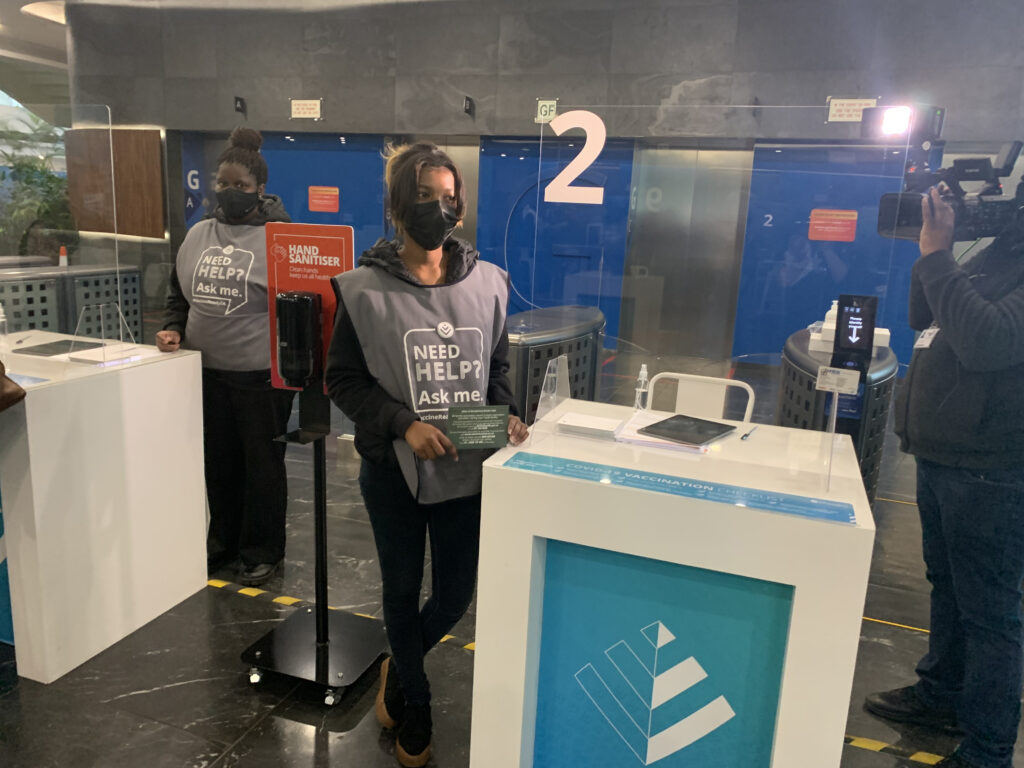 Clients’ identity documents, vaccination bookings, voucher numbers and medical aid details are verified at the vaccination registration centre. (Bhekisisa Centre for Health Journalism)
Clients’ identity documents, vaccination bookings, voucher numbers and medical aid details are verified at the vaccination registration centre. (Bhekisisa Centre for Health Journalism)
Medical aids pay for vaccinations in full and reimburse Discovery Health directly. If someone isn’t on medical aid, Discovery can bill the government for the cost if the EVDS booked the person for an appointment at the site.
But for walk-ins — people who weren’t booked on the EVDS — this works differently.
The government will only reimburse “public patient walk-ins” at private sites for up to 5% of the site’s vaccination capacity, because it wants to avoid issuing sites with “blank cheques”, said Nicholas Crisp, a deputy director general in the health department, who helps to manage the Covid-19 vaccination programme.
The capacity of the site is about 2 200 to 2 300 vaccinations a day, so the government will only reimburse Discovery for up to 115 walk-ins a day, said Discovery Health’s chief executive, Ryan Noach.
Getting your jab
Once registered, a client moves to a waiting area — the last stop before getting a jab. This area is divided into four groups of well-spaced chairs. Generally, no one waits for longer than 30 minutes here.
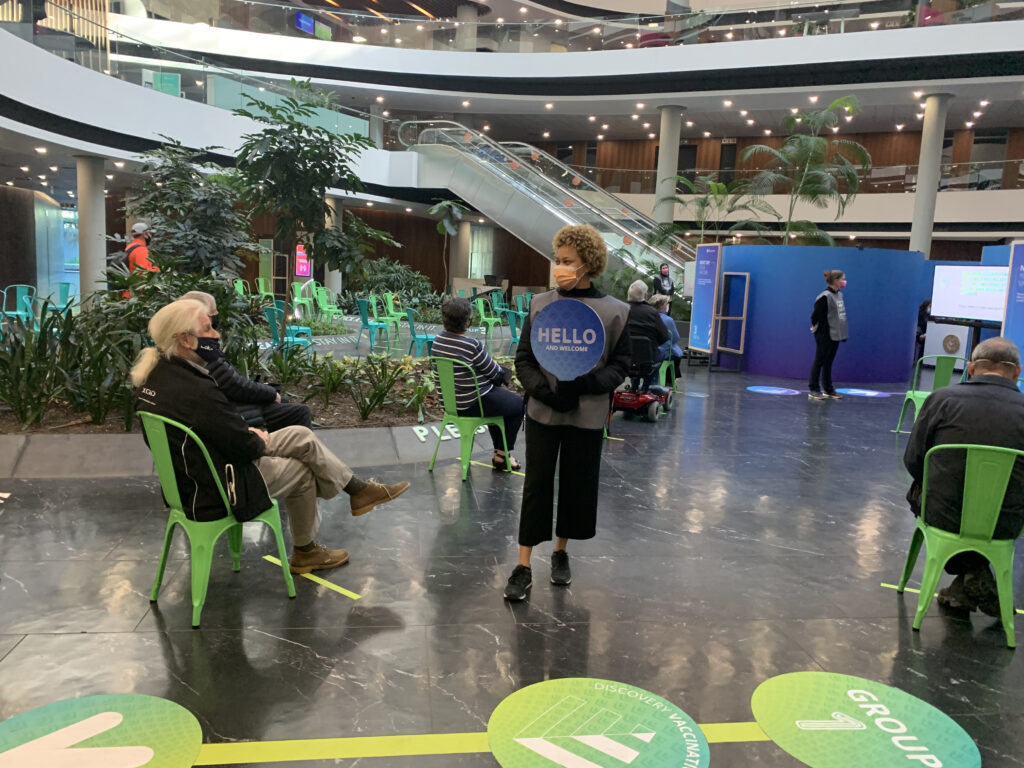 People wait here for a vaccination booth to become available. (Bhekisisa Centre for Health Journalism)
People wait here for a vaccination booth to become available. (Bhekisisa Centre for Health Journalism)
There are 30 vaccination booths — 15 on the ground floor and 15 on the first floor. Each vaccinator spends about seven minutes with a person getting a shot. They give them information, screen them for potential side-effects and then administer the jab. All the vaccinators are registered nurses who have completed an online training course in how to administer a Pfizer shot.
 Furber Nothard, 70, from Lonehill in Johannesburg, gets his first Pfizer shot. (Bhekisisa Centre for Health Journalism)
Furber Nothard, 70, from Lonehill in Johannesburg, gets his first Pfizer shot. (Bhekisisa Centre for Health Journalism)
The vaccinators don’t draw the vaccine in the syringes themselves. They receive a prepared syringe with the correct amount of vaccine (0.3ml) in it. The syringes are prepared by specially trained nurses, supervised by pharmacists, in a central room in the building. The exact location of the room is kept secret for security reasons.
“Vaccines have become hot commodities,” says Noach. “They come with strict security protocols.”
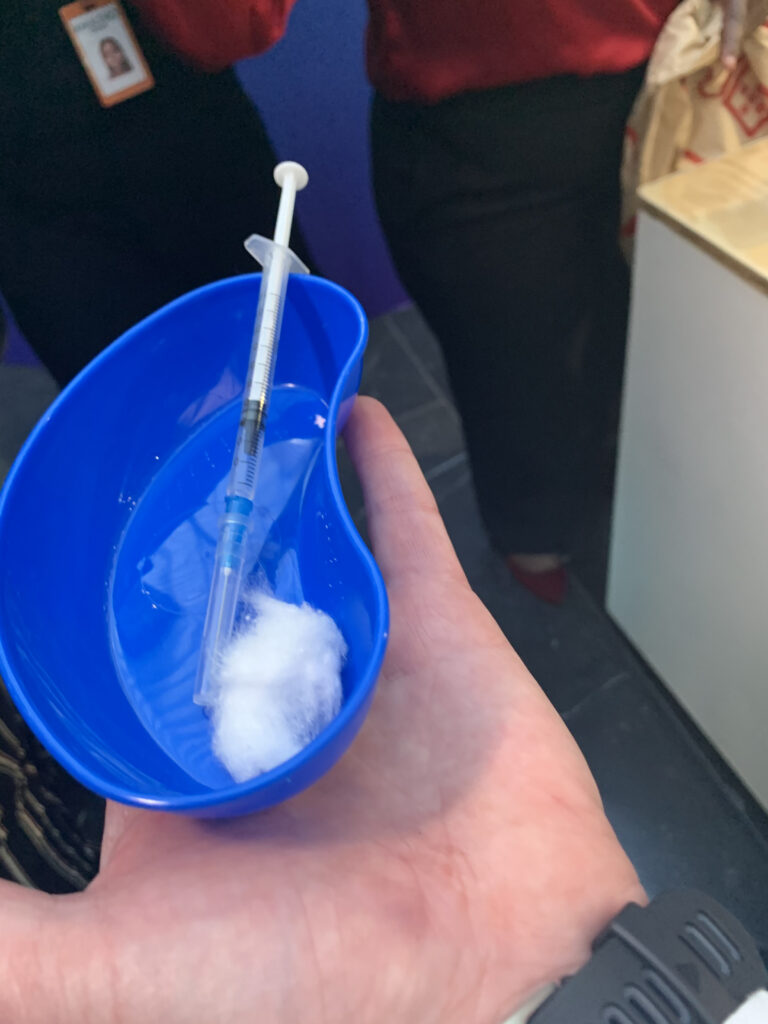 Vaccinators receive syringes filled with the vaccine and administer the jab. (Bhekisisa Centre for Health Journalism)
Vaccinators receive syringes filled with the vaccine and administer the jab. (Bhekisisa Centre for Health Journalism)
Preparing the syringes with vaccines is a task that requires skill. Pfizer shots arrive frozen in vials. There are six doses in each vial. The vials have to be thawed and the vaccine then has to be diluted with the correct amount of saline solution to get six doses out of a vial. But there’s a snag: the contents of the vials consist of microscopic particles that can’t be seen by the human eye and the vials can’t be shaken when the salt water is added, only gently swirled.
Once the vials are thawed, the unopened little bottles can be kept in a fridge for up to 31 days. But when they’re removed from a fridge and opened, so that the contents can be diluted with salt water, the diluted vaccine must be administered within six hours.
The Discovery site uses about 400 vials of Pfizer vaccine a day and the site normally has at least four to five days of stock on hand, says Noach. He says the stock usually arrives with an expiry date of two to three months after the delivery date.
The same trained staff dilute all doses, so that the skill of mixing the doses with saline is adequately learned, and the possibility of doses being wasted is as low as possible.
 This is the vial in which Pfizer vaccines, known as Comirnaty, arrive. There are six doses in one vial. (The vial in the photograph is empty.)
This is the vial in which Pfizer vaccines, known as Comirnaty, arrive. There are six doses in one vial. (The vial in the photograph is empty.)
Step 4: Post-vaccination observation for side-effects
The final step is for a vaccinated person to spend 15 to 30 minutes in a waiting area so that they can be observed for potential vaccine-related side-effects such as severe allergic reactions. Most people are asked to stay here for 15 minutes, but those with a high risk profile, such as people with a history of severe allergies, are asked to stay for 30 minutes. A full-time doctor is on-site to assist in case of emergencies.
Side-effects are a normal part of the vaccination process and people ordinarily recover from them within a few days. But most vaccine-related side-effects are mild.
Data from a UK study that analysed the information that people who had received a Pfizer jab reported on an app called the Covid-19 Symptom Study App, showed that 66% of vaccinated people who used the app between December and March reported experiencing local after-effects such as pain, swelling and tenderness at the site of injection. About one in four people declared side-effects that affected their whole body, such as nausea, fatigue and diarrhoea.
In February, the US government’s Centres for Disease Control reported about 4.5 cases of anaphylaxis for every one million Pfizer doses administered. Anaphylaxis is a severe, potentially life-threatening allergic reaction, which could include skin irritations, lowered blood pressure, trouble breathing and nausea.
Noach says no incidents of severe allergic reactions have been reported among the more than 12 000 people who had been vaccinated at the Discovery site by the end of last week.
This story was produced by the Bhekisisa Centre for Health Journalism. Sign up for the newsletter.
